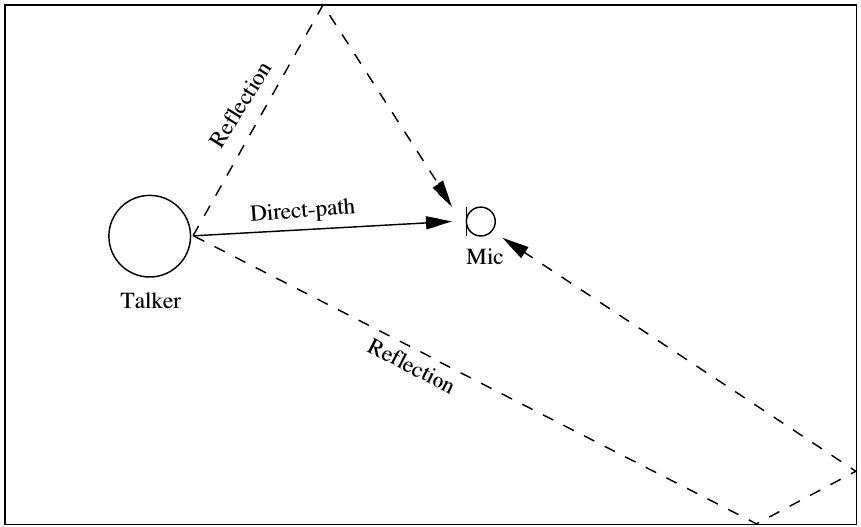Speech Degradation Through Reverberation
The Problem of Reverberation
When speech signals are recorded in a room by a microphone, the acquired signal from the microphone contains not only the direct sound from the speaker but also the reflected sound from the walls, ceiling, and floor of the room. This phenomenon is known as reverberation. The direct sound arrives first, followed by a series of reflections that arrive later, creating a complex mixture of sounds. In Figure 1 (taken from Speech Dereverberation (2010)), we see a schematic representation of this process.

The perceptual effect of reverberation is that it can make speech less intelligible and more difficult to understand. Typical perceptual effects of reverberation are:
- Box effect: The speech sounds as if it is coming from a box or a large room, adding spaciousness to the sound.
- The distant talker effect: The speech sounds as if it is coming from a distance.
In some cases, when these effects are carefully controlled, they can be desirable. For example, in music production, reverberation is often added to create a sense of space and depth in the sound. However, in speech communication, especially in telephony and hearing aids, excessive reverberation can degrade the quality of the signal and make it difficult to understand. Reverberation changes the characteristics of the speech signal, which might become an issue with speech processing applications such as automatic speech recognition (ASR) and speaker recognition. The effects become more pronounced when the speaker is farther away from the microphone, as the direct sound is weaker compared to the reflected sound.
Overcoming Reverberation Through Microphone Placement
Speech reveberation in a room environment can be reduced by careful microphone placement. In particular, the microphone should be placed as close to the speaker as possible. This is often achieved by using a headset microphone or a lavalier microphone. The closer the microphone is to the speaker, the stronger the direct sound will be compared to the reflected sound, reducing the effects of reverberation. Although this quick and easy approach is effective, it is not always practical and can be inconvenient for the speaker. In some scenarios, like teleconferencing with multiple speakers or in a conference room, it may not be possible to place the microphone close to the speaker. Thus, signal processing techniques are often used to overcome the need for close microphone placement.
In the upcoming posts, we will try to describe some of the types of noise introduced by reverberation and how to overcome them. We will also explore some classic algorithms for dereverberation in speech processing during the pre-machine learning era. These algorithms are still relevant today and can be used as a baseline for comparison with modern machine learning approaches.